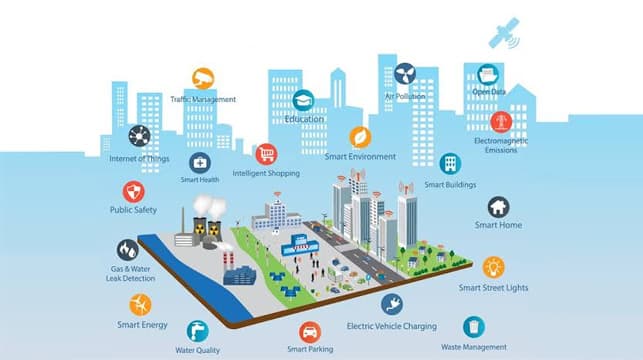Where Innovation Meets Urban Life

A Smart City using IoT (Internet of Things) refers to an urban area that uses interconnected devices and data technologies to enhance the quality of life for its citizens, optimize infrastructure, improve city services, and reduce resource consumption.
Key Features of a Smart City
- 1. Smart Traffic Management
- • Sensors on roads and traffic lights monitor vehicle flow.
- • Real-time traffic data helps reduce congestion and guide drivers.
- • Integration with apps like Google Maps or city-specific traffic apps.
- 2. Smart Waste Management
- • Bins with fill-level sensors alert collection services when full.
- • Optimized collection routes save time and fuel.
- 3. Smart Lighting
- • Streetlights equipped with motion sensors adjust brightness based on presence.
- • Reduced energy consumption and increased public safety.
- 4. Smart Water Managemen
- • IoT meters detect leaks, monitor usage, and ensure efficient distribution.
- • Helps in conservation and reduces water loss.
- 5. Air Quality Monitoring
- • Sensors monitor pollution levels, alert citizens, and support policy decisions.
- • Data helps cities enforce regulations and promote public health.
- 6. Smart Parking
- • oT-based systems guide drivers to available parking spots, reducing emissions and frustration.
- 7. Public Safety & Surveillance
- • Real - time data from CCTV, gunshot detectors, and emergency call systems.
- • Quicker response times and better crime prevention.
- 8. Energy Management
- • Smart grids monitor and balance energy consumption across the city.
- • Integration with renewable energy sources (e.g., solar panels).
Benefits
- 1. Efficiency in resource use and services.
- 2. Reduced operational costs for cities.
- 3. Improved urban planning through data analysis.
- 4. Better quality of life for residents.
- 5. Environmental sustainability.
“A Smart City is an urban area that uses technology and data to improve the quality of life for its residents, enhance the efficiency of services, reduce environmental impact, and ensure sustainable growth.”
© Copyright 2024. All Rights Reserved by Bagus Harapan Tritunggal

